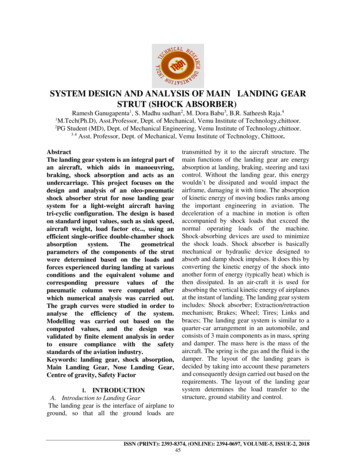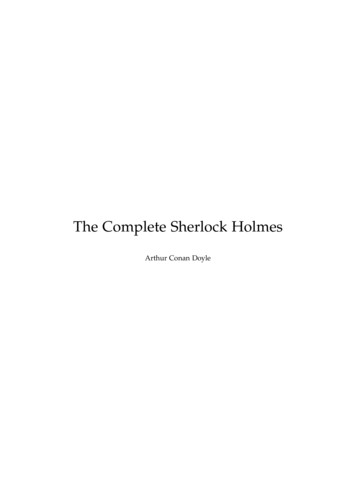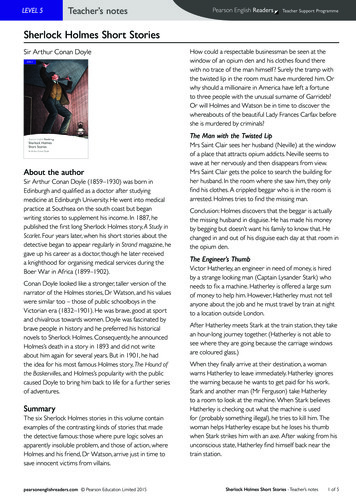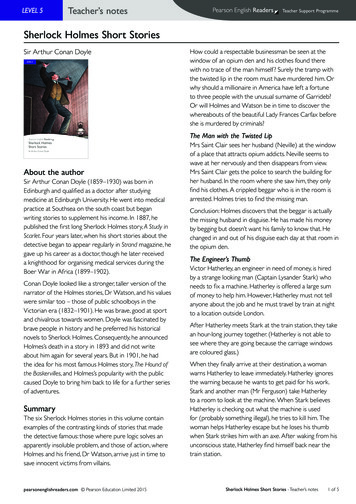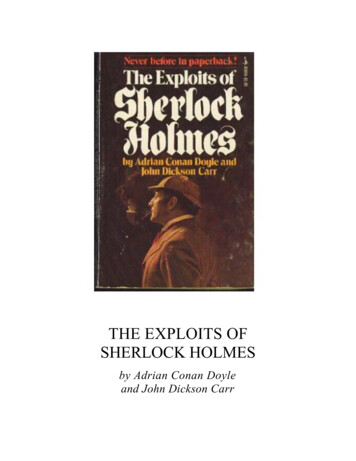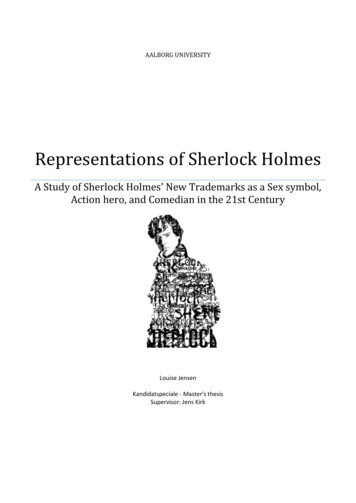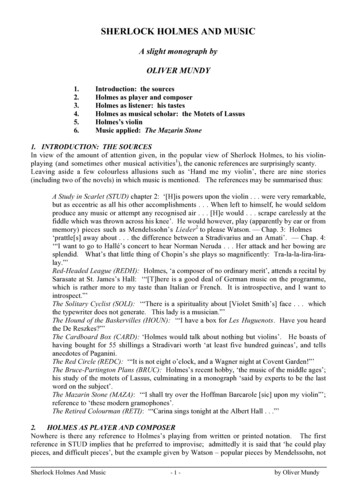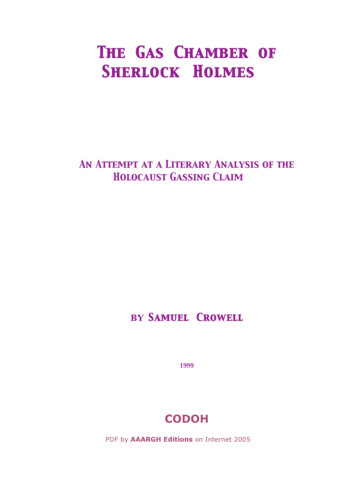
Transcription
The Gas Chamber ofSherlock HolmesAn Attempt at a Literary Analysis of theHolocaust Gassing Claimby Samuel Crowell1999CODOHPDF by AAARGH Editions on Internet 2005
Samuel CROWELL : The Gas Chambers of Sherlock Holmes"In Memoriam!"Dec 22, 1997: Revised Jan 10, 1999Analytical Table of ContentsIntroductionThe First ReportsGerman Disinfection ProceduresThe First Reports from Auschwitz and MajdanekThe Eastern Camps, Polevoi's Report, and the Gerstein StatementThe Canonical HolocaustThe Nuremberg TrialsThe Confessions of Rudolf HößInterpreting Documents and the Postwar LiteratureRetrofitting the Euthanasia CampaignThe Fear of Cremation and Poison GasGerman Civil DefenseCivil Defense in the Concentration CampsPressac's "Criminal Traces"The Gas Chamber of Sherlock HolmesConclusionsNOTES—2—
Samuel CROWELL : The Gas Chambers of Sherlock Holmes1. IntroductionA COMMON BELIEF is that in World War Two the National Socialist government ofGermany carried out a secret policy of mass exterminations, chiefly using exterminationgas chambers. The policy is said to have been ordered by Adolf Hitler, and involved thegassing of millions of human beings, who subsequently were burned either in crematoriaor in huge pits so that scarcely a trace of their bodies remained.The claim of mass gas extermination has been questioned ever since the late1940's, but only by a few people, and very much on the fringe of public discourse.2 Inthe early 1970's several new critics of the gas extermination claim emerged, and overthe past two decades they have been joined by many others, so that now there are atleast several dozen who have written on the subject.3 These researchers considerthemselves heir to the tradition of those historians who sought in the 1920's to revise,and de-politicize, our understanding of the First World War, and so consider themselveshistorical revisionists. But the skepticism of these researchers towards mass gassing isusually accompanied by a desire to reevaluate the Holocaust in its entirety, and as aresult they are more normally called "Holocaust revisionists" or "Holocaust deniers".4The response of traditional historiography to the challenge of the revisionists hasnot been what one would expect. Normally, when someone challenges a historicalorthodoxy, a minute analysis of the material and documentary record ensues, and therecord is correspondingly revised. But nothing of the sort has happened here: instead,the arguments of the revisionists have been ignored and they have been reviled.5In recent years, the expression of revisionist skepticism has been criminalized inseveral European countries, leading to heavy fines and prison terms, particularly inGermany and France.6 In Canada, two major trials have been held with the intention ofsilencing a gas chamber critic.7 Most recently the Prime Minister of Great Britain, duringhis candidacy, repeatedly promised to ban revisionist writings about the Holocaust.8The further erosion of free speech on this matter must be considered intolerable toanyone who takes the intellectual life seriously. Therefore the purpose of this essay willbe to deliberately review the gassing claim, with the object, not to prove that gassingsdid or did not take place, but rather to investigate whether there is a plausible basis forrevisionist doubt. If we find that the traditional gassing narrative contains sufficienterrors or lacunae to justify doubt, then we must allow doubt. On the other hand, if wefind that the traditional gassing narrative has an irrefutable documentary or materialbase, then we must note this also. The result should be, in the first case, due recognitionof revisionist contributions to the ongoing process of modern historiography, or, in thesecond case, a further marginalization of revisionist thinking, which should render theirinfluence harmless and thus unobjectionable. But in any case we cannot continue thecurrent situation where revisionists are dismissed as not serious even while many ofthem are punished with quite serious fines and prison terms.The method we shall use is largely determined by the inherent problems of thesubject, specifically the problems concerning text and source criticism. Even if charitablyinclined, anyone with minimal historical training cannot fail to notice how traditionalHolocaust scholars take a generally uncritical, selective, and anachronistic position withregards to their evidence. From a mass of materials that support, or seem to support,their position, they simply select heavily edited excerpts here and there.9 Rarely is anattempt made to explain the theoretical underpinnings of the selection or verificationprocess for testimonies or affidavits. Rarer still are attempts to place the frequentlyambiguous evidence in a wider documentary context. When the original sources containerrors or data inconsistent with the traditional interpretation, no attempt is made toexplain the source or significance of these errors and inconsistencies.—3—
Samuel CROWELL : The Gas Chambers of Sherlock HolmesFinally, traditional Holocaust scholars pay no attention to the chronologicalevolution or even the circumstances of gassing claims, even though it should be obviousthat earlier statements, widely publicized, have a strong potential for influencing laterpermutations of a claim. This last is a particularly glaring omission, since the vastmajority of Holocaust evidence is gleaned from testimonial or affidavit narratives. Inshort, the overall impression created by the traditional school's method is one of simplyselecting data that supports what everyone already knows.The revisionist approach has its own strengths and weaknesses. Its greateststrength has been its willingness to subject the standard evidentiary texts to rigorouscriticism. But even here, there has been a tendency to confuse debunking with historicalexplanation. It is not enough to say that this or that affidavit contains several errors andis therefore suspect, nor, for that matter, is it enough to carry out forensic studies andshow the extreme unlikelihood of specific gassing claims. There have been enormouscontributions in this latter area in the past decade, and the researches of Faurisson,Berg, Rudolf and Mattogno have gone a long way to define the physical limits againstwhich testimonies and affidavits must be tested.10 Nevertheless, to show with a fairdegree of probability that the mass gassings were impossible is not the same thing asexplaining why everyone believes they took place.Therefore we begin at the beginning with the simple proposition that the gassingclaims are either true or not true. If they are true, then the historian should be able toestablish how the claims came to be known, and at what point the fugitive claims ofwartime crossed the threshold of fact. On the other hand, if the claims are false it shouldbe possible to explain how they emerged, how they were constituted, and why they werebelieved. In short, the problem requires a chronological method.In general the tendency in most writings on the Holocaust has been to ignore thedifference between rumor and fact: the traditional school considers all rumors fact, therevisionists consider all facts rumor.11 It is precisely at this juncture, then, that we seemto have a promising point of departure, since all parties, traditional or revisionist, agreethat the gassing claims began as vague, anonymous, and unverifiable reports, that is, asrumors.Fact is a reflection of empirical reality; but rumor expresses a reality all its own,however difficult it is to define, since the real world of rumor is simply that world ofunspoken assumptions, associations, and projections that characterize a human cultureat a specific moment of historic time. Attempts to describe the parameters and nature ofthat unspoken world, which in some ways is more real than the real world, at least interms of determining our perception and our judgment, has been a main project amongintellectual historians and literary critics at least since the early 1960's.By way of a simple example: in 1976 a literary detective named Samuel Rosenbergwrote a book entitled Naked is the Best Disguise: The Death and Resurrection of SherlockHolmes. Rosenberg closely analyzed the Holmes stories in order to argue that ConanDoyle was expressing in his work a great number of late Victorian concerns: Evolution,Nietzsche's theories, German secret societies and bellicose nationalism, the White Man'sBurden, and so forth. While we can debate his success is mapping out Conan Doyle'sspecific intellectual concerns, his book did succeed in placing the stories firmly within aspecific cultural context, thus helping to explain their content.We want to pursue a similar path here, and hence propose a literary analysis in achronological format. That is, while skeptical of the gassing claims, we are not setting asour primary objective to prove or disprove any specific gassing claim. Instead we willhave a simple narration of the gassing claims, from the spring of 1942 through the endof the Nuremberg and Auschwitz Trials in 1947. The analysis shall be "literary" because it—4—
Samuel CROWELL : The Gas Chambers of Sherlock Holmeswill focus on the themes, motifs, tropes, and story elements that comprise the gassingclaims. To put it another way, the gassing claims will be laid out, viewed as narratives oras "texts", arranged in order, and analyzed separately and in combination.Literary analyses usually involve several different steps. One is simply thebreakdown of a text into its parts along with a discussion of these. In the present casethis will involve the isolation and tracking of some of the gassing claim story elements. Asecond step involves a textual analysis, in which the text is arrayed with similar textsthat may have influenced it or which may have been influenced by it. Precisely for thisreason, judgment on the veracity of claims will be suspended, in favor of investigatingwhether a given narrative shows textual links with prior or later texts. A third approachplaces the text in a broader social and cultural context, in order to see how it relates to,or expresses, its culture. In the present case the emerging story elements will be placedin the context of known historical and cultural crosscurrents, most of which have beenundervalued or ignored by traditional historians of this subject. By putting thesematerials in context, it will be possible to see the extent to which the gassing claim was,or was not, peculiar to its time.After discussing the various story elements of the emerging gassing claim threefacts should become clear. First, the mass gassing narratives have a strong familyresemblance among them and even to texts that predated the supposed gasexterminations by 20 years or more. Second, the unique characteristics of the gassingprocess can be traced, in the broader context of European social and cultural history, tocompletely ordinary procedures, albeit procedures which were the source of significantsocial and cultural anxiety. Finally, it should become plain that there is no documentaryor material evidence that unambiguously supports the mass gassing claim: thosedocuments that are said to bear even remotely on the gassing claim are, in context,completely benign, and for the most part refer back to the anxiety-producing proceduresjust discussed. These conclusions will not prove that there were no mass gassings. Theywill, however, vindicate revisionist doubt.It will of course be impossible to indefinitely withhold a final judgment on thesource or character of the gassing claims. But we can take guidance from two cautionaryremarks of Conan Doyle's Baker Street sage. "How often have I said to you that whenyou eliminate the impossible, whatever remains, however improbable, must be thetruth?" said Sherlock Holmes to Dr. Watson in The Sign of Four. To be sure, the historianmust always be willing to face uncomfortable truths. "I should have more faith," Holmesremarked in A Study in Scarlet, "I ought to know by this time that when a fact appearsopposed to a long train of deductions it invariably proves to be capable of bearing someother interpretation." Indeed, it is precisely to the reasonable possibility of "some otherinterpretation" that all historical investigation must be dedicated.Yet no one can authoritatively deny the existence of something that most everyoneelse accepts as true. Therefore categorical denials of mass gassing are not possible. Onecan, however, try to explain how the gassing claim could have arisen quite naturallygiven the characteristics and concerns of early 20th Century social and cultural life. It willbe shown that the gassing claim, as a form of the more general extermination claim,comprises elements of specific concern to East European Jews since the early 19thCentury. It will also be shown that the traditional extermination scenario, featuring ashower-gas-burning sequence, is rooted in profound European and American concernsover disease and disease prevention, the use of poison gas and other mysteriousweapons of mass destruction, and finally anxiety and fear over the recent reappearanceof cremation as a means of disposal of the dead.In short, it will be possible to see that the generation of a delusion of mass gasextermination did not require a conspiracy, or a hoax, nor much conscious effort at all,but only a social and cultural climate that would facilitate the generation of such claims,—5—
Samuel CROWELL : The Gas Chambers of Sherlock Holmesat a time of war, hatred, and social anomie. We will see that such claims, facilitated hereand there by a little helpful fraud, but above all by a simple willingness to believe theworst about one's enemies, would allow these rumors to be stated as fact and becomethemselves part of that social and cultural landscape of which we are only halfconsciously aware.A few caveats are probably in order. Many people still feel that to question themass gassing claim, or for that matter, any other aspect of the Holocaust, is tantamountto dismissing the enormous suffering and loss of life experienced by the Jewish people inWorld War Two, and that it is even "wicked" to pose questions that may cause survivorsany further suffering.12As to the first point, it is only because of the emphases of recent historiographythat the mass gassing claim has come to be so exclusively associated with the Jewishpeople and the Holocaust. In 1945, it was commonly claimed that ten million or morehad been exterminated at the same half dozen camps where today three million Jewsalone are said to have been gassed,13 the implication is clear that at the time it wasbelieved that more non-Jews than Jews had in fact been exterminated with poison gas.14Moreover, mass gassing has been reconstructed as having been applied first to insaneand disabled non-Jewish Germans in the course of the Euthanasia campaign. Therefore,skepticism of the mass gassing claim intersects, but does not embrace, the totality of theHolocaust.As to the second point: the argument that we must spare the feelings of survivorsis essentially an appeal to compassion. For many years, we were swayed, and eventroubled, by this argument, but we have seen in recent times that this compassion hasbeen invoked to justify persecution and censorship. So now the value of compassion hasbeen placed at odds to the free reason of the individual. But in fact all compassion, andall human action, can only flow from the reasoned choice of free human beings. Weconclude, therefore, that the most positive end is served by insisting on the right of freepeople to speak their minds.NOTES1.Already the present essay in its research phase has given rise to two specialistarticles, "Technique and Operation of German Anti-Gas Shelters: A Refutation of J. C. Pressac's 'CriminalTraces'" and"Defending Against the Allied Bombing Campaign: Air Raid Shelters and Gas Protection inGermany, 1939-1945, Parts 1 and 2". These articles correspond to sections 12 through 14. The presentessay may stand on its own, but it is also in effect an outline for further extended treatments.2.The first revisionists include the Frenchman, Paul Rassinier (d. 1967), active from1948, a former inmate of Buchenwald (see his collected writings, Debunking the Genocide Myth, Instituteof Historical Review (IHR), Newport Beach, CA: o. p.), and the Rumanian Jew, Josef Ginzburg (d. 1990),whose family was persecuted and deported during World War Two, writing under the pseudonym, J. G.Burg, from 1962. There is no easily available precis of revisionist historiography, Arthur R. Butz, TheHoax of the Twentieth Century, IHR, Newport News, CA:1983 contains some information, pp. 10-12; pp.317-334.3.Some descriptive matter is found in Butz, op. cit., loc. cit., and consult also cumgrano salis Shermer, Why People Believe Weird Things, W. H. Freeman, NY:1997, pp. 173-252. AfterRassinier and Burg, "Holocaust revisionism" essentially begins with Arthur R. Butz, whose book was firstpublished in 1976 (1977 in the US): Robert Faurisson in France and Wilhelm Stäglich in Germanyemerged almost simultaneously along with others. The end of the '70's witnessed the debut of the Journalof Historical Review [hereinafter JHR], the primary English-language organ of revisionist writings. The1980's found important writings by James G. Martin, Friedrich Berg, and Mark Weber, they were joined inthe 1990's by, among others, Carlo Mattogno and John Ball. The 1988 Zündel trial also witnessed the—6—
Samuel CROWELL : The Gas Chambers of Sherlock Holmesentrance of the British historian David Irving into the revisionist fold, although to this date his writingshave not heavily engaged the topic of the Holocaust as such, but see his Goebbels (1996) andNuremberg:The Last Battle (1996), both issued by Focal Point in London.4.Shermer, Michael, op. cit., loc. cit., provides a definition of revisionist positions, oras he calls it, "Holocaust Denial": (1) intentional genocide on racial grounds; (2) "highly technical, wellorganized" program, using gas chambers and crematoria, (3) between five and six million dead. Shermeris to be credited for not demonizing revisionists, although his treatment leaves much out. More to thepoint, we do not know of any other historical event where the facts are set as preconditions to theconcept, furthermore, not all revisionists give equal weight to each of the three "conditions". In thepresent case, while we have doubts about the extent of (1) and (3), we do not consider themhistoriographically interesting. On the other hand, we are certain that (2), at least as stated, is false.5.Typical are the descriptions of revisionists that one finds in Lipstadt, Deborah,Denying the Holocaust: The Growing Assault on Truth and Memory, Penguin Books (Plume), NY:1994, wenote in particular the introduction where revisionist "deniers" are characterized as plague-spreading rats.6.Revisionism is thus outlawed in Germany, France, Switzerland, and Israel.7.Two trials were carried out against Ernst Zündel, in 1985 and 1988; BarbaraKulaszka prepared a digest of the transcripts of the second trial, printed as Did Six Million Really Die? andhis available on the Zündel-site on the Internet [hereinafter, DSMRD].8.Tony Blair's promises in news reports, 16 Oct 96, and 30 Jan 97.9.This is evident, for example, in Raul Hilberg's Destruction of the European Jews,Quadrangle, Chicago:1968, which, on the subject of gas exterminations restricts itself to heavily editedtestimonies of two Nazis, taken under vastly different circumstances, two ambiguous documents, and anumber of postwar memoirs of former concentration camp inmates.10.The forensic approach is largely the brainchild of Robert Faurisson who already in the1970's sought to compare the arrangement of gassing facilities in Poland with known gas executiontechnology in the United States. In the late 1980's, while preparing for the second Zündel trial, an expertin US execution technology, Fred Leuchter, was commissioned to write a report on the gassing sites inPoland. The resulting Leuchter Report (1988) was a milestone in Holocaust forensics, although its mainconclusion, that the crematoria at Birkenau could never have been used for gassing, has been hotlydisputed. Leuchter's main scientific conclusions, that the crematoria bore unexpectedly low cyanidetraces, considering their supposed use, have been reproduced in several studies by both sides, but theinterpretation of these low to non-existent traces has been variously argued and appears inconclusive.The most thorough and rigorous study of forensic issues related to cyanide residues remains the RudolfReport (Gutachten), but the German chemist Germar Rudolf, published in 1992 and subsequently revised.Rudolf, under the pseudonym Ernst Gauss has also edited the important collection of studies, Grundlagenzur Zeitgeschichte, Grabert Verlag, Tübingen:1994 [hereinafter Grundlagen], as well as the revisionistperiodical, Viertelsjahrhefte für freie Geschichtforschung [hereinafter VffG], 1997-present.11.As evidence of the first, we cite Walter Laqueur's The Terrible Secret: Suppression ofthe Truth About Hitler's 'Final Solution', Little, Brown & Co., Boston:1980, which repeats every bit ofinformation coming from occupied Poland as proof of the extermination policy, even when he isconstrained to admit that it is inaccurate.12.Laqueur, Walter, Fascism: Past, Present, Future, Oxford UP, New York:1996, p. 141.13.Soviet Special Commissions and contemporary reports had established death tolls asfollows: Treblinka, 3-3.5 million, Auschwitz Birkenau, at least 4 million, Majdanek, 1.5 million, Sobibor,Chelmno, several hundreds of thousands, Belzec, 600,000. For a survey of death estimates as of 1946,including some even higher than the above, consult Aroneanu, Eugene, Inside the Concentration Camps,translated by Thomas Whissen, Praeger Publishers, Westport, CT: 1996, pp. 143-144.14.Ibid., The implication may not be correct: according to one of Aroneanu's witnesses theJewish component always comprised 90% of the total, whatever that might be, loc. cit. This seems illogical. Italso seems illogical to attribute to the Nazis a policy of exterminating non-Jews if, in the interval of 50 years, ithas been accepted that in fact something on the order of seven millions were not exterminated at these sixcamps.—7—
Samuel CROWELL : The Gas Chambers of Sherlock Holmes2. The First ReportsMOST HOLOCAUST RESEARCHERS begin their analysis of the gassing claims in thespring of 1942, so we shall follow that custom here.15 We are not concerned withrecording every single enumeration of a gassing claim; we are concerned above all withrecording characteristic changes in how the story is reported. Throughout 1942, 1943,and well into the summer of 1944, all claims of mass gassing must be considered asuncorroborated rumors: therefore, after briefly covering the evolution of the story wemust pause and attempt to provide other possible explanations for these rumors that arenot keyed to the assumption that they reflect reality. To that end, we will have to dulynote a few other rumors pertaining to alleged German National Socialist activities thatare generally conceded to be untrue today, that is, rumors that assumed a life of theirown in the Second World War.It should be pointed out here that in the spring of 1942 the National Socialistgovernment of Germany began to systematically deport all Jewish persons in Europe toPoland, and, according to their claims, to points farther east. There is no denying thatthese deportations were cruel, or that they involved the unjust seizure of wealth andbelongings, or that many Jews were done to death one way or another during thisprocess. Virtually everyone, revisionist and non-revisionist, agrees about this aspect ofthe National Socialist persecution of the Jewish people.There is also agreement that in the subsequent course of the war hundreds ofthousands of Jews were dragooned into the German labor system, particularly into thearmaments industry, working largely out of concentration camps, and several types oflabor camps, and that the death rate in these camps was very high, particularly at theend of the war when disease control measures and provisioning completely broke down.The question is whether in the course of these concentrations in Poland and subsequentdeportations farther east the German National Socialists were also carrying out a policyof deliberate extermination of Jewish people, specifically using poison gas.The first claim of mass gassing pertaining to Jewish people that received widecirculation was contained in the so-called Bund Report that was smuggled to the PolishGovernment in exile, located in London, in the third week of May, 1942.16 The reportcontained two gassing rumors: first that a special automobile (a gas chamber) was beingused to gas 90 persons at one time.17 Since the victims were supposed to have dug theirgraves before being gassed, it follows that this was more a gas chamber that could bemoved from place to place than a gas van (normally conceived as a vehicle that woulddrive victims to a grave while they died from gas inhalation on the way).18 The secondrumor pertains to actions in Warsaw: it is said that Jews were being experimented uponwith poison gases.19The Bund Report, in turn, appears to be a composite of at least two documentsthat had come from Warsaw during the spring of 1942. The first of these was anunderground communication from the Jewish Labor Bund, in Warsaw, dated March 16,1942, which described German activities in Western Poland as follows:"In a number of villages the Jews were put to death by gas poisoning. They wereherded in a horrible way into hermetically sealed trucks transformed into gas chambers,in groups of fifty, entire families, completely nude ."20 and further alleged that "gaspoisoning" was being carried out in Lodz.21 The second document that contributed to theBund Report was a lead article in Der Veker, April 30, 1942, at a time of internecinestruggle between Jewish resisters and collaborators in the Warsaw ghetto.22 That articleis the source of most of the numerical totals in the Bund Report, but it is interesting thatneither of these documents indicate 700,000 total dead.23 The April 30, 1942 Der Vekerarticle also specifies Chelmno as the site of poison gassings, without giving details, but it—8—
Samuel CROWELL : The Gas Chambers of Sherlock Holmesis worth noting that from the March 16 communication there is an implied connection ofbathing (the enforced nudity) and gassing, although, as we shall see, it will be somemonths before either element become dominant in the recitation of atrocities.Two of the members of the Polish National Council in exile were Jewish:Zygielbojm and Szwarcbart, and they could be expected to be particularly interested inwhat was being alleged about their co-religionists several hundred miles away underGerman military occupation, and, in spreading these allegations as a means of gettingsupport for their people.24 The Bund Report was thus extensively publicized in themedia.Already on June 24, 1942, the Bund Report was summarized on the BBC.25 Thefollowing day, the Daily Telegraph ran a major story on the Report, with two headlines ofnote: "Germans murder 700,000 in Poland," and "Traveling Gas Chambers".26 Thefollowing day, Zygielbojm delivered a broadcast over the BBC, summarizing the BundReport, in Yiddish, and hence obviously directed to the Jewish population in Poland.27Within a week, the BBC had made an arrangement with the Polish National Council givingthe BBC priority in the reporting of all future atrocity stories.28On July 1, 1942, the Polish Fortnightly Review published a report, based on theallegations made in the Bund Report, and now also mentioning specific camps: Sobibor,and Majdanek, near Lublin.29 It also made a reference to atrocities at Auschwitz,described as a labor camp, where about a thousand Soviet and Polish POW's weresupposed to have been gassed the previous September, as well as to another campnearby, called 'Paradisal' -- the name, so the report alleged, because "from it there isonly one road, leading to Paradise."30 It further alleges that the crematoria in theParadisal camp were five times larger than at Auschwitz, and that experiments withpoison gas were conducted there.31 It should be emphasized that the remarks in thePolish Fortnightly Review concerning Auschwitz were not in the Bund Report; they appearto have come from earlier reports that were sent to London.32Looking over these initial claims it is clear that the claim of gassing is but one of anumber of extermination claims being made. It is furthermore true that the claims ofgassing focus more on the allegation of experiments rather than a systematicextermination procedure. On the Auschwitz claims, there are some startling inaccuracies:Paradisal is clearly a reference to Birkenau, but Birkenau had no crematoria until thefollowing spring, and the term Paradisal itself, as a road to paradise, is obviously theorigin of the "Himmelfahrt" that will later figure so prominently in the folklore of Sobiborand Treblinka but which has no place in the history of Birkenau.33The other thing that is important to note in this first rush of stories about gassingsis that the BBC has already begun to play a major role in recycling these rumors back totheir point of origin in Poland.34 These broadcasts in effect create a feedback loop thatrepeats and gives authority to Polish rumors, which are then re-injected back intoPoland, where they may be expected to multiply and burgeon. There will be more to sayof these broadcasts shortly, but the role of radio in disseminating and universalizing therumors of mass gassing is something that deserves a very thorough accounting.By July 16, 1942, the allegations of gassing were repeated in the News Review,here with the claim
wrote a book entitled Naked is the Best Disguise: The Death and Resurrection of Sherlock Holmes. Rosenberg closely analyzed the Holmes stories in order to argue that Conan Doyle was expressing in his work a great number of late Victorian concerns: Evolution, Nietzsche's theories, German se

